 |
|
21 - 25 August 2011
San Diego Convention Center
San Diego, California United States |
SPIE Optics and Photonics
 |
|
21 - 25 August 2011
San Diego Convention Center
San Diego, California United States |
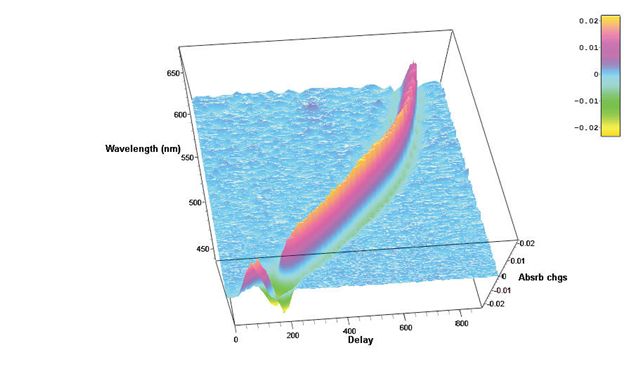 |
Hatteras-D
femtosecond transient absorption data acquisition system Future nanostructures and biological nanosystems will take advantage not only of the small dimensions of the objects but of the specific way of interaction between nano-objects. The interactions of building blocks within these nanosystems will be studied and optimized on the femtosecond time scale - says Sergey Egorov, President and CEO of Del Mar Photonics, Inc. Thus we put a lot of our efforts and resources into the development of new Ultrafast Dynamics Tools such as our Femtosecond Transient Absorption Measurements system Hatteras. Whether you want to create a new photovoltaic system that will efficiently convert photon energy in charge separation, or build a molecular complex that will dump photon energy into local heat to kill cancer cells, or create a new fluorescent probe for FRET microscopy, understanding of internal dynamics on femtosecond time scale is utterly important and requires advanced measurement techniques. Reserve a
spot in our
Ultrafast Dynamics Tools
training workshop in San Diego, California. |
|
|
Beacon Femtosecond Optically Gated Fluorescence Kinetic Measurement System
-
request a quote -
pdf Reserve a
spot in our
Ultrafast Dynamics Tools
training workshop in San Diego, California. |
Del Mar Photonics Products updates
Strong intramolecular coupling in organic cyclic aggregates
Paper 8113-39 of Conference 8113
Date: Monday, 22 August 2011
Author(s): Jessica Donehue, Oleg Varnavski, Theodore G. Goodson III, Univ. of
Michigan (United States) - featured
customer!
A series of π-extended cyclic thiophene oligomers of 12, 18, 24, and 30 repeat
units have been studied using methods of ultrafast time-resolved absorption,
fluorescence up-conversion, and three-pulse photon echo. Our results indicated
an initial delocalized state can be seen upon excitation of the cyclic
thiophenes. Anisotropy measurements show this delocalized state decays on an
ultrafast timescale and is followed by the presence of incoherent hopping. Using
theoretical models, our ultrafast anisotropy decay measurements suggest the
system does not reside in the Förster regime and coherence within the system
must be considered. Three-pulse photon echo peak shift experiments reveal a
clear dependence of initial peak shift with ring size, indicating a weaker
coupling to the bath (and stronger intramolecular interactions) as the ring size
is increased.
Ultrafast studies of charge carrier dynamics in nanomaterials
and relevance to solar energy conversion
Paper 8109-21 of Conference 8109
Date: Thursday, 25 August 2011
Author(s): Jin Zhong Zhang, Univ. of California, Santa Cruz (United States)
Charge carrier dynamics in nanostructures play a critical role in their
performance for light energy conversion. A better fundamental understanding of
processes will significantly aid the design of new nanostructures for various
applications including solar energy conversion. In this presentation, we will
review our recent efforts on using ultrafast laser techniques to probe charge
carrier dynamics in a number of MO systems, including TiO2, WO3, and Fe2O3
nanoparticles and nanorods, to demonstrate the important correlation between
charge carrier properties and structural characteristics of the nanomaterials.
Electronic cooling in a single flake of bi-layer graphene studied by
ultrafast spectroscopy
Paper 8101-18 of Conference 8101
Date: Tuesday, 23 August 2011
Author(s): Enrico Da Como, Thomas Limmer, Jochen Feldmann,
Ludwig-Maximilians-Univ. München (Germany)
We report the first experiments probing the carrier relaxation on a single flake
of bi-layer graphene with femtosecond resolution. We have probed carrier
relaxation by ultrafast pump-probe spectroscopy in the femtosecond time scale.
This allows us for obtaining snapshots of the carrier population distribution
after the initial photoexcitation pulse at 1.55 eV. By modeling the carrier
distributions as two separated Fermi-Dirac distributions for electrons and holes
we extract carrier temperatures and cooling rates. Our analysis shows that
carriers loose half of their energy within the first 500 femtoseconds by
carrier-phonon scattering. The results are relevant for graphene optoelectronic
devices.
THz wave up-frequency turning by rapidly plasma creation
Paper 8119-19 of Conference 8119
Date: Sunday, 21 August 2011
Author(s): Masahiro Nakata, Takeshi Higashiguchi, Noboru Yugami, Utsunomiya
Univ. (Japan); Yasuhiko Sentoku, Univ. of Nevada, Reno (United States); Ryosuke
Kodama, Osaka Univ. (Japan)
When plasmas are instantaneously created around an electromagnetic wave,
frequency of the wave up-converted to the frequency, which depends on the plasma
frequency. We have demonstrated the proof of principle experiment using the
interaction between a terahertz wave and plasmas created by an ultra short laser
pulse, which ensures the plasma creation time-scale much shorter than a period
of electromagnetic source wave and plasma length longer than a wavelength of the
wave. We observed frequency up-conversion from 0.35 THz to 3.3 THz by the
irradiance of the Ti:sapphire laser in ZnSe crystal.
Tunable terahertz radiation from an ultrashort-laser-pulse-induced discharge in
biased air
Paper 8119-20 of Conference 8119
Date: Sunday, 21 August 2011
Author(s): Fuminori Suzuki, Takeshi Higashiguchi, Hiroaki Anno-Kashiwazaki,
Noboru Yugami, Utsunomiya Univ. (Japan); Yasuhiko Sentoku, Univ. of Nevada, Reno
(United States); Ryosuke Kodama, Osaka Univ. (Japan); Patric Muggli, The Univ.
of Southern California (United States)
We have demonstrated a proof-of-principle peak-frequency-tunable THz radiation
source based on laser-triggered plasma ultrafast-spark. An unified physical
picture for the peak frequency-versus laser pulse duration dependency in the
spark, based on the plasma sheath current model together with a plasma expansion
driven by the OFI (optical-field-induced ionization), is also presented. The new
coherent tunable THz source will allow further developments in nonlinear THz
photonics and optics, such as nonlinear phonon excitation and THz phase
transition on dielectric surfaces.
Optical nonlinearity and power limiting in organic molecules and nanocomposites
Paper 8113-18 of Conference 8113
Date: Monday, 22 August 2011
Author(s): Reji Philip, Raman Research Institute (India)
We have measured the optical nonlinearity of different novel organic and
composite systems including nanocomposite polymer films of Au, Ag and Pt,
Organic ionic crystals (pyridinium and quinolinium salts), Au-alkanethiol
clusters, thiophene based polymers, and Schiff base complexes, using the z-scan
and degenerate four wave mixing techniques, employing laser pulses of nanosecond
and femtosecond durations respectively. It is found that most of these materials
are efficient optical power limiters (except a few showing saturable absorption)
under the present excitation conditions. The third order nonlinear
susceptibilities and figure of merit values for these media have been
determined.
Broadband ultrafast all-optical processing with nematic liquid crystals
Paper 8114-22 of Conference 8114
Date: Monday, 22 August 2011
Author(s): Kuan-Lun Hong, Shuo Zhao, Iam Choon Khoo, The Pennsylvania State
Univ. (United States)
We present a critical review of the nonlinear optical responses of transparent
as well as plasmonic- or dye-doped nematic liquid crystals. Experimental studies
have demonstrated the feasibility of sub-microseconds - nanoseconds all-optical
one-way switching of nanoseconds pulsed lasers spanning the entire visible -
near infrared regime (488nm, 532 nm, 750 nm, 1060 nm, 1550 nm). These effects
will be useful for developing tunable metamaterials and to realize
faster-response version of many coherent optical image processing applications
demonstrated previously with slower mechanisms. References: I. C. Khoo, Physics
Report 471, pp. 221-267 [2009]; I. C. Khoo et al, Molecular Crystals Liquid
Crystals 527, pp. 109-118 (2010); M. Y. Shih, A. Shishido and I. C. Khoo, Opt.
Letts. 26, pp 1140-1142 (2001); M. Y. Shih, I. C. Khoo, A. Shishido, M. V. Wood,
P. H. Chen, Opt. Letts. 25, pp. 978-980(2000).
Laser-induced localized strain and ultrafast absorption in the ablation of thin
film solar cells
Paper 8110-29 of Conference 8110
Date: Monday, 22 August 2011
Author(s): Stefano Buratin, Enrico Favero, Paolo Villoresi, Univ. degli Studi di
Padova (Italy)
Selective removals of areas as well as the realization of narrow channels in the
multilayer structure are central issues in thin film solar cell technology. The
difference in optical absorption and the different mechanical parameters allow
for the exploitation of laser-driven non contact removal processes based on
different principles. We focus on the layer removal along channels for the
serial connections of the cell. The two opposing cases of ultrafast absorption
and of controlled thermal stress are investigated for their potentials in
reaching a clean layer separation with sharp edges, to point out the optimal
laser process for the different cell layers, that we think to be potentially
superior with standard approaches.
Ultrafast nonlinearities of plasmonic metamaterials
Paper 8093-15 of Conference 8093
Date: Monday, 22 August 2011
Author(s): Mengxin Ren, Andrey Nikolaenko, Eric Plum, Nikolay I. Zheludev, Univ.
of Southampton (United Kingdom)
We report on extraordinary strong nonlinear
properties and ultrafast transient dynamics of gold-based plasmonic
metamaterials and metamaterial nanostructures aggregated with semiconductor
nanotubes
Ultrafast coherent optical signal processing technologies and applications using
stabilized optical frequency combs (Keynote Presentation)
Paper 8164-9 of Conference 8164
Date: Monday, 22 August 2011
Author(s): Peter J. Delfyett, Jr., CREOL, The College of Optics and Photonics,
Univ. of Central Florida (United States)
This paper presents recent results in the development of novel coherent
ultrafast technologies based on the generation and application of stabilized
optical frequency combs. By using novel active resonant cavity injection locking
techniques, filtering, modulation and detection can be performed directly on
individual components of the frequency comb enabling new approaches to optical
waveform synthesis, waveform detection, synthetic aperture imaging and matched
filtering, with effective signal processing bandwidths in excess of 1 THz.
Charge transfer processes at intra- and intermolecular heterojunctions
Paper 8098-18 of Conference 8098
Date: Monday, 22 August 2011
Author(s): Enrico Da Como, Ludwig-Maximilians-Univ. München (Germany)
Photoinduced charge transfer is the primary process in photovoltaics. Here we
probe the first steps of charge separation in a series of low-bandgap
donor-acceptor copolymers by femtosecond infrared pump-probe spectroscopy. The
results are discussed considering the donor acceptor strength of the units
within the chain and how this influences the yield of polaron generation. In the
second part we will combine the pump-probe experiments with time resolved
luminescence to study charge separation at polymer/fullerene intermolecular
heterojunctions. Upon doping of the conjugated polymer we report reduced
recombination via charge transfer excitons and enhanced polaron formation.
Beyond the adiabatic limit: charge separation in organic photovoltaic materials
Paper 8098-19 of Conference 8098
Date: Monday, 22 August 2011
Author(s): John B. Asbury, Ryan D. Pensack, The Pennsylvania State Univ. (United
States)
The dynamics of charge separation in photovoltaic polymer blends following
photoinduced electron transfer from the conjugated polymer, CN-MEH-PPV, to the
electron accepting functionalized fullerene, PCBM, are observed with ultrafast
vibrational spectroscopy. Temperature dependent measurements reveal that the
rate of charge transfer exciton dissociation to form free carriers occurs by
concerted electron - phonon propagation in organic semiconductors. The results
emphasize the importance of strong coupling of electronic and nuclear degrees of
freedom to the mechanism of charge separation in organic photovoltaic materials.
Optical nonlinearities of triphenylamine substituted tridentate pyridyl
ruthenium complexes
Paper 8113-29 of Conference 8113
Date: Monday, 22 August 2011
Author(s): Xingzhong Yan, Ming Yan, Peifen Lu, South Dakota State Univ. (United
States); Heping Zeng, East China Normal Univ. (China)
Nonlinear refractive index n2 of new polypyridyl ruthenium complexes was
measured by using Z-scan techniques with femtosecond laser pulses. It was found
that the symmetry and coplanarity of ruthenium complex was quite important for
obtaining high nonlinear optical refractivity. Meanwhile, no clear nonlinear
absorption behavior was found for the four complexes at 800 nm, which indicated
that the ruthenium complexes had a large real part of third-order
susceptibilities but a very small imaginary part. This will highly extends their
potential applications in nonlinear optical fields.
Ultrafast conformational readjustment through non-adiabatic state crossings in
oligofluorenes
Paper 8098-24 of Conference 8098
Date: Monday, 22 August 2011
Author(s): Jenny Clark, Univ. of Cambridge (United Kingdom); Guglielmo Lanzani,
IIT@POLIMI, Milano (Italy) and Politecnico di Milano (Italy); Sergei Tretiak,
Los Alamos National Lab. (United States)
We apply an ultrafast pump-push-probe experiment and advanced computational
techniques to investigate energy relaxation in oligofluorenes in solution.
Results suggest direct observation in the time domain of ultrafast photoinduced
planarization of oligofluorenes via internal conversion through non-adiabatic
state crossings. We find a clear correlation between the ultrafast planarization
and an intra-molecular charge transfer state whose ultrashort lifetime is
exploited in realizing all optical switching in plastic media.
Plasmonic enhancement of ultrafast all-optical magnetization reversal
Paper 8096-25 of Conference 8096
Date: Monday, 22 August 2011
Author(s): Vladimir Kochergin, Lauren A. Neely, MicroXact Inc. (United States);
Ilya N. Krivorotov, Univ. of California, Irvine (United States); Eugene V.
Kochergin, Donetsk National Technical Univ. (Ukraine); Kang L. Wang, Univ. of
California, Los Angeles (United States)
We report theoretical and experimental investigation of the prospects of
plasmonic enhancement of inverse Faraday Effect (IFE) and ultrafast all-optical
magnetization reversal. It is theoretically shown that IFE is significantly
enhanced around plasmonic nanostructures. Four orders of magnitude of IFE
enhancement is predicted for certain plasmonic structures. Moreover, modeling
results indicate that significant IFE around plasmonic nanostructures can be
observed under linearly polarized illumination conditions. Model predictions are
verified by experimental demonstration of ultrafast all-optical magnetization
reversal in GdFeCo alloy around plasmonic nanostructure at 100 times smaller
value of laser fluence to pulse duration ratio than without plasmonic
nanostructure.
Plasmonic field enhancement for generating ultrafast extreme-ultraviolet light
pulses
Paper 8096-27 of Conference 8096
Date: Tuesday, 23 August 2011
Author(s): In-Yong Park, Seungchul Kim, Joonhee Choi, Seung-Woo Kim, KAIST
(Korea, Republic of)
In this report, we show a 3-dimensional metallic waveguide that enables
plasmonic generation of ultrashort EUV pulses through field enhancement by means
of surface-plasmon polaritons. Compared with bow-ties previously used for field
enhancement by stationary resonance of localized surface plasmons, the net
volume of more than 20 dB intensity enhancement turns out to be three orders of
magnitude larger. The intensity of incident NIR pulses is enhanced by a factor
of ~350, being strong enough to produce EUV harmonics up to the 43rd order in
interaction with Xe gas directly from a modest input of ~1011 Wcm-2.
Adiabatic and nonadiabatic metallization of dielectric nanofilms by strong
optical fields
Paper 8096-28 of Conference 8096
Date: Tuesday, 23 August 2011
Author(s): Mark I. Stockman, Maxim Durach, Anastasia Rusina, Georgia State Univ.
(United States); Matthias F. Kling, Max-Planck-Institut für Quantenoptik
(Germany)
We consider a 1-10 nm-thin nanofilm of an insulator subjected to a strong
oscillating electric field normal to it. The frequency of this field may be in
the range from microwave to optical, depending on the film thickness (in the
near-ir to visible range for a ~1-2 nm thickness). The strength of this field is
considered to be in the range ~1-10 V/nm. A slow, adiabatic field induces a
reversible phase transition in the film to a metallic state. The electrons can
be transferred between the nanofilm's surfaces We also demonstrate that a
femtosecond pulse causes ultrafast formation of plasmonic band in the
high-frequency response of a nanostructure. This ultrashort pulse creates a
non-equilibrium excitation of the nanostructure, which can be controlled using
adiabatic phase accumulation effect. The demonstrated possibility of ultrafast
switching between insulator and plasmonic metal phases can be employed for
creation of active plasmonic elements for ultrafast nanocircuits
Dynamic optical media: ultrafast bandgap photonics application
Paper 8095-14 of Conference 8095
Date: Tuesday, 23 August 2011
Author(s): Michael K. Rafailov, RCI Inc. (United States)
It is known that ultra-fast laser is able to change the physical state of
solids: to melt, to evaporate, to ionize. It is less known that ultra-fast laser
is able to change the optical state of some solids: to bleach it. The effect is
most pronounced in semiconductors were the bandgap amplifies the effect in
highly non-linear manner. Change in optical state is on the scale of
recombination time Such short time changes in semiconductor optical
characteristics depend on the bandgap structure, therefore we are introducing
the term - Ultrafast Bandgap Photonics. Phenomena of Ultrafast bandgap photonics
are time-dependent and bandgap-dependent the optical effects are reversible:
ultra-fast laser "bleaches" semiconductor and temporally changes spectral
reflectivity, absorptivity, and transmittance as well as polarization
characteristics.
Strong field amplification of XUV: phase matching aspects
Paper 8140-10 of Conference 8140
Date: Tuesday, 23 August 2011
Author(s): Jozsef Seres, Enikoe Seres, Friedrich-Schiller-Univ. Jena (Germany);
Boris Ecker, GSI Helmholtzzentrum für Schwerionenforschung GmbH (Germany);
Bjoern Landgraf, Friedrich-Schiller-Univ. Jena (Germany); Daniel C. Hochhaus,
Daniel Zimmer, Vincent Bagnoud, Bastian Aurand, Bernhard Zielbauer, Thomas
Kuehl, GSI Helmholtzzentrum für Schwerionenforschung GmbH (Germany); Christian
Spielmann, Friedrich-Schiller-Univ. Jena (Germany)
We extended the description of high harmonic generation by adding stimulated
emission and named it x-ray parametric amplification (XPA). Super-quadratic
increase of the XUV signal with the pressure is predicted by HHG theory in a
limited pressure range, but other observed characteristics like exponential
growth, gain narrowing, strong blue shift etc. and their scaling can be only be
explained accurately by the new XPA model. We experimentally realized XPA in
Argon gas in the spectral range of 40-50 eV in excellent agreement to the
theory. XPA holds the promise to realize a new class of bright x-ray sources for
spectroscopy.
Ultrafast nanoscale imaging using high order harmonic generation
Paper 8140-12 of Conference 8140
Date: Tuesday, 23 August 2011
Author(s): Hamed Merdji, Commissariat à l'Énergie Atomique (France)
Ultrafast coherent diffraction using soft and hard X-rays is actually
revolutionizing imaging science. Indeed, new ultrashort pulses recently
available hold the promise of watching matter evolving with unprecedented space
and time resolution. We have recently taken up the challenge of ultrafast
coherent imaging of nanometric objects, such as nano-particles using our
table-top soft X-ray laser harmonic source. We have very recently demonstrated
nanoscale imaging in a single shot mode reaching 70 nm spatial resolution and 20
femtoseconds snapshot [1]. We then implemented a recently proposed holographic
technique using extended references. This technique, easy to implement, allows a
direct non iterative image reconstruction. In the single shot regime, we
demonstrated a spatial resolution of 110nm [2]. [1] A. Ravasio et al., Phys.
Rev. Lett. 103, 028104 (2009). [2] D. Gauthier et al., Phys. Rev. Lett. 105,
093901 (2010).
Transient absorption study on photogenerated carrier dynamics in visible light
responsive photocatalysts GaN:ZnO
Paper 8109-3 of Conference 8109
Date: Tuesday, 23 August 2011
Author(s): Akihiro Furube, National Institute of Advanced Industrial Science and
Technology (Japan); Kazuhiko Maeda, Kazunari Domen, The Univ. of Tokyo (Japan)
Transient absorption of visible light responsive powder photocatalysts, solid
solution of GaN and ZnO (GaN:ZnO), and other related materials were measured by
using femtosecond diffuse reflectance spectroscopy. The GaN:ZnO is known to be
one of successful photocatalysts which split water into oxygen and hydrogen
molecules under visible-light irradiation. We have elucidated that the charge
trapping was within time resolution (~200 fs) and recombination time was about
100 ps for 30% of carriers and much longer for 70%, clearly indicating that most
of photogenerated carriers have long lifetime to ensure the efficient
reactivity.
Ultrafast active control of optical eigenmodes in a multiple scattering nanowire
layer
Paper 8095-24 of Conference 8095
Date: Tuesday, 23 August 2011
Author(s): Otto L. Muskens, Martina Abb, Univ. of Southampton (United Kingdom);
Erik P. A. M. Bakkers, Technische Univ. Eindhoven (United Kingdom)
We demonstrate ultrafast modulation of light transmitted through layers of
semiconductor nanowires. The nanowires form one of the most strongly scattering
materials available today [1]. The nonlinear response of individual pseudomodes
is found to be governed by dephasing of multiple scattering light paths on a
picosecond time scale. The new dephasing nonlinearity results in large intensity
modulations of around 50%, holding promise for ultrafast control of eigenmodes
in nanophotonic switches, random lasers, and cavity quantum electrodynamics. [1]
O. L. Muskens et al., Nano Lett. 9, 930 (2009)
Temporally shaping ultrafast light with metamaterials
Paper 8093-40 of Conference 8093
Date: Tuesday, 23 August 2011
Author(s): Dean P. Brown, UES, Inc. (United States); Augustine M. Urbas, Air
Force Research Lab. (United States)
Coherent excitation in optical spectroscopy and control of photo-induced
processes like second harmonic generation depend on the temporal properties of
ultrafast pulses. In this work, we demonstrate that metamaterials can be
fabricated to have very large spectral dispersion properties that can affect
both the temporal envelope and phase of each spectral component of an ultrafast
pulse in useful ways. After experimentally testing the resultant pulse shape due
to these materials, we explore the effects on second harmonic generation and two
photon fluorescence and examine how the structure orientation of the
metamaterial changes these effects.
All-optical control of single plasmonic nanoantenna-ITO hybrids
Paper 8096-39 of Conference 8096
Date: Tuesday, 23 August 2011
Author(s): Otto L. Muskens, Univ. of Southampton (United Kingdom); Martina Abb,
Univ. of Southampton (United States); Nicolas Large, Javier Aizpurua, Centro de
Física de Materiales (Spain) and Donostia International Physics Ctr. (Spain)
We demonstrate experimentally picosecond all-optical control of a plasmonic
nanoantenna embedded in indium tin oxide. We show that optical pumping of ITO
leads to a local reduction of the free-carrier density in the substrate. The
transient nonlinear response of the antenna-ITO hybrid shows a redshift of the
plasmonic resonance, as opposed to transient bleaching of isolated gold
antennas. We propose that the hybrid nonlinear response is caused by a
picosecond energy transfer mechanism involving hot electron injection from gold
into ITO. Hybrid plasmonic components are of interest for active control of
optical fields and integration of photonic and electronic functionalities.
Physical processes behind a Ti:Sa femtosecond oscillator
Paper 8121-42 of Conference 8121
Date: Wednesday, 24 August 2011
Author(s): Manuel Fernández-Guasti, Eduardo Nava-Palomares, Fernando Acosta,
Univ. Autónoma Metropolitana-Iztapalapa (Mexico); Chandrasekar Roychoudhuri,
Univ. of Connecticut (United States)
The sharply peaked comb structure from a mode-locked cavity is explained in
terms of the superposition. However, the non interference of waves implies that
these wave-fields cannot sum themselves without matter interaction. The
summation has to be carried out either by wave-mixing within a nonlinear medium
and/or it is performed by the detector. The output of a femtosecond Titanium
Sapphire femtosecond oscillator is analyzed. The data is examined from three
viewpoints: a) the superposition takes place within the cavity, b) the
superposition occurs at the detector, c) the superposition takes place with no
medium.
Light-field control of electronic motion at nanoscaled condensed matter
interfaces
Paper 8096-50 of Conference 8096
Date: Wednesday, 24 August 2011
Author(s): Agustin Schiffrin, Max-Planck-Institut für Quantenoptik (Germany);
Tim Paasch-Colberg, Max-Planck-Institut für Quantenoptik (Germany) and
Technische Univ. München (Germany); Daniel Gerster, Technische Univ. München
(Germany); Nick Karpowicz, Max-Planck-Institut für Quantenoptik (Germany);
Sascha Mühlbrandt, Max-Planck-Institut für Quantenoptik (Germany) and Technische
Univ. München (Germany); Joachim Reichert, Johannes V. Barth, Technische Univ.
München (Germany); Reinhard Kienberger, Technische Univ. München (Germany) and
Max-Planck-Institut für Quantenoptik (Germany); Ralph Ernstorfer,
Fritz-Haber-Institut der Max-Planck-Gesellschaft (Germany) and
Max-Planck-Institut für Quantenoptik (Germany) and Technische Univ. München
(Germany); Ferenc Krausz, Max-Planck-Institut für Quantenoptik (Germany) and
Ludwig-Maximilians-Univ. München (Germany)
Our research aims to exploit intense ultrashort laser pulses with tunable
carrier envelope phase (CEP) to generate and control electronic motion in
nanoscaled circuits. Here, we demonstrate the generation of directly measurable
photocurrents at unbiased metal-dielectric nano-interfaces, whose magnitude and
directionality can be tuned with the optical field CEP. This effect, which
vanishes with increasing laser pulse duration, is the signature of optically
induced electron tunneling at the heterogeneous interface with subsequent
acceleration of the carrier in the few-cycle laser field. This ultrafast current
injection at a nanoscaled system represents a first step towards solid state
lightwave electronics.
Ultrafast single and multiple electron transfer from quantum dots
Paper 8098-1 of Conference 8098
Date: Sunday, 21 August 2011
Author(s): Tianquan T. Lian, Emory Univ. (United States)
In this presentation we report a series of studies of exciton dissociation
dynamics in quantum dots (QDs) by electron transfer to adsorbed electron
acceptors. We show that excitons in CdSe and PbS QDs can be dissociated on the
picosecond timescale to various adsorbates. We demonstrate that multiple
excitons per QD (generated by multiple photons) can be transferred to adsorbed
acceptors. We will discuss the dependence of the electron transfer rates on the
size and the nature of the quantum dots and possible approaches to optimize the
multiple exciton dissociation efficiency.
Ultrafast kinetics in polycrystalline pentacene: Exciton fission
Paper 8098-7 of Conference 8098
Date: Sunday, 21 August 2011
Author(s): Mark W. B. Wilson, Akshay Rao, Univ. of Cambridge (United Kingdom);
R. Sai Santosh Kumar, Istituto Italiano di Tecnologia (Italy); Daniele Brida,
Giulio Cerullo, Politecnico di Milano (Italy); Richard H. Friend, Univ. of
Cambridge (United Kingdom)
We use broadband transient absorption spectroscopy with sub-20 fs time
resolution to examine the process of exciton fission in evaporated
polycrystalline films of pentacene. We find that the majority of initially
photogenerated singlet excitons evolve into triplet excitons on an ~80 fs
timescale independent of the excitation wavelength, which is consistent with
fission occurring from a non-equilibrium delocalized state. This direct
demonstration that triplet generation is both rapid and efficient establishes
multiple exciton generation by this process as an attractive route to increased
efficiency in organic solar cells.
Ultrafast Gain switching of THz quantum cascade lasers: THz pulse amplification
and injection seeding
Paper 8119-10 of Conference 8119
Date: Sunday, 21 August 2011
Author(s): Sukhdeep S. Dhillon, Nathan Jukam, Dimitri Oustinov, Julien Madeo,
Ecole Normale Supérieure (France); Stefano Barbieri, Christophe Manquest, Carlo
Sirtori, Univ. Paris 7-Denis Diderot (France); Suraj Khanna, Edmund Linfield,
Giles Davies, Univ. of Leeds (United Kingdom); Jerome Tignon, Ecole Normale
Supérieure (France)
Terahertz (THz) time domain spectroscopy is now widely used technique where it
is essential to know both the amplitude and phase of a THz wave. Nonetheless,
THz amplifiers, capable of increasing the THz wave field, are presently lacking.
In this context THz quantum cascade lasers (QCL) are very promising devices for
amplification. Gain clamping in these devices, however, limits the attainable
amplification. Here we circumvent gain clamping by coupling a THz QCL and an
integrated Auston-switch to perform ultrafast gain switching. The resulting
non-equilibrium gain is not clamped above laser threshold and large
amplification of input terahertz pulses is demonstrated.
Ultrafast Imaging of Microbubble Cavitation using Integrated Optical Trapping
for Spatial Control: Progress and Prospects
Paper 8097-14 of Conference 8097
Date: Sunday, 21 August 2011
Author(s): Paul A. Campbell, Univ. of Dundee (United Kingdom)
In this review paper, the lead authors and architects of two seminal papers in
the area of cpmbined optical trapping and high speed imaging [1,2] bring their
collective experience together for the first time, assessing the process of how
their respective integrative solutions converged, and moreover how emerging
technologies such as the use of spatial light modulators can be exploited fully
in this context. A full reference list, including all conference papers in this
area, is included, so that this review represents a completely up-to-date
snapshot of the state of the art, as well as a sober assessment of where the
most fruitful future directions may lie, given the rapidly evolving technologies
underpinning modern high speed imaging systems.
Ultrafast photocurrent in the nanotube PN junction: probing the interplay
between electron-hole pair creation and annihilation
Paper 8111-25 of Conference 8111
Date: Monday, 22 August 2011
Author(s): Nathaniel M. Gabor, Massachusetts Institute of Technology (United
States); Zhaohui Zhong, Univ. of Michigan (United States); Ken Bosnick, National
Research Council of Canada, Univ. of Edmonton (Canada); Paul McEuen, Cornell
Univ. (United States)
Understanding the efficent generation (creation) and recombination
(annihilation) of electron-hole pairs in low-dimensional devices, as well as
developing new optoelectronic nanotechnologies that incorporate efficient
generation of multiple electron-hole pairs [1], will require the ability to
measure individual device behavior at time scales comparable to electron motion.
In individual carbon nanotubes (NTs), purely optical [2-6] and purely electronic
[7] measurements have probed carrier dynamics at ultrafast (sub-picosecond) time
scales by exploiting intrinsic nonlinear processes. In nanoscale optoelectronic
devices, the microscopic details and characteristic time scales of nonlinear
processes determine device performance limits for applications in ultrafast
photodetectors, light emitting diodes (LEDs), lasers, and energy harvesting
devices. Therefore, understanding the physical mechanisms that lead to nonlinear
behavior is of paramount importance, yet no measurements have combined ultrafast
optical and electronic techniques to probe the fundamental nonlinear processes
in individual NTs at subpicosecond time scales. Here, we present the first
ultrafast photocurrent measurements of an individual NT optoelectronic device
that explore the interplay between efficient creation and annihilation of
electron-hole pairs. By using ultrafast lasers to excite photocurrent in a
nanotube PN junction, we are able to probe optoelectronic device behavior at
sub-picosecond time scales. Using this technique, we directly probe the transit
of electrons and holes across the device in the time domain, finding that charge
carriers escape the junction and travel to the device contacts within ~1
picosecond. The carrier escape time is found to result from an electric
field-dependent velocity, in which carriers in the first subband (of effective
mass m1 *) escape the device in half the time as carriers in the second subband
(m2 * = 2m1 *). Additionally, we observe strong photocurrent saturation at high
optical powers that occurs more dramatically for carriers excited into the
second subband ε2. We attribute this strong saturation to the annihilation of
electron-hole pairs by high-energy free carriers, a process that is more
efficient for ε2 carriers due to energy and momentum constraints.
The mechanism of ultrafast exciton dissociation in neat regioregular
poly(3-hexylthiophene)
Paper 8098-23 of Conference 8098
Date: Monday, 22 August 2011
Author(s): Gianluca Latini, Istituto Italiano di Tecnologia (Italy); Francis
Paquin, Paul-Ludovic Karsenti, Maciej Sakowicz, Univ. de Montréal (Canada);
Natalie Stingelin-Stutzmann, Imperial College London (United Kingdom); Carlos
Silva, Univ. de Montréal (Canada)
Numerous publications report charge photogeneration yields ≤30% on
sub-picosecond timescales in neat regioregular poly(3-hexylthiophene) films.
Here, we probe charge photogeneration and subsequent recombination dynamics over
six decades in time spanning up to microseconds by means of time-resolved
photoluminescence spectroscopy. We find that charge photogeneration at 10K
occurs continuously over sub-nanosecond timescales, and not by diffusion-limited
exciton dissociation. Rather, we conclude that it is an extrinsic process that
occurs efficiently at interfaces between photophysical aggregate and
non-aggregate domains, and is driven by interfacial energetic disorder.
Ultrafast energy transfer in Pt-containing macromolecules at low temperature
Paper 8113-40 of Conference 8113
Date: Monday, 22 August 2011
Author(s): Daniel Flynn, Theodore G. Goodson III, Univ. of Michigan (United
States)
Platinum containing macromolecular structures are important for the development
of novel optical, electrical, and energy related applications. These materials
are potentially promising for optical limiting and other nonlinear absorption
applications. Previous experiments have detailed the nonlinear optical
properties of these materials. And in this poster we present information
regarding the fundamental excitations in these systems utilizing ultra-fast
pulses. In these studies we utilize fluorescence upconversion to probe the
relaxation process with very fast time resolution. We also investigate the
materials in neat samples where the concentration is particularly high to offer
investigation of the inter-molecular interactions as well. The results of this
study are used to describe the mechanism for the enhanced nonlinear properties
of platinum acetylide
Ultrafast switching of semiconductor microcavities
Paper 8095-13 of Conference 8095
Date: Tuesday, 23 August 2011
Author(s): Georgios Ctistis, Willem L. Vos, Emre Yüce, Univ. Twente
(Netherlands); Julien Claudon, Jean-Michel Gérard, Commissariat à l'Énergie
Atomique (France)
We study frequency-resolved femtosecond pump-probe reflectivity of planar
GaAs-AlAs microcavities. In the free carrier excitation regime we observe a
not-adiabatic change of the frequency of probe light to a value different from
the cavity resonance. By judicious choice of pump and probe frequencies with
respect to the semiconductor bandgap we can determine the switching process to
be governed by the electronic Kerr effect. We studied this regime and
demonstrate that we shift the resonance by a linewidth on a timescale governed
only by the cavity storage time.
Optical response and ultrafast spectroscopy of metal-based hybrid nanoobjects
Paper 8096-49 of Conference 8096
Date: Wednesday, 24 August 2011
Author(s): Fabrice Vallee, Denis Mongin, Anna Lombardi, Paolo Maioli, Aurelien
Crut, Natalia Del Fatti, Univ. Claude Bernard Lyon 1 (France)
The optical properties of nanohybrids, i.e., nanoparticles formed different
materials as two metals or a metal and a semiconductor, are still little
studied, though they are very promising for plasmonic applications. Experimental
investigations will be presented in the case of ensemble and single hybrid
metal-semiconductor nanoparticles, focusing on the impact of interfacing the two
materials on their individual excitation features, i.e., surface plasmon
resonance and exciton. The nonlinear ultrafast response of the same systems has
also been studied using time-resolved pump-probe spectrocopy. The results yield
evidence for ultrafast sub 10 fs charge transfer between the two materials.
FEL-pumped inner-shell photoionized x-ray laser
Paper 8140-1 of Conference 8140
Date: Tuesday, 23 August 2011
Author(s): Nina Rohringer, Lawrence Livermore National Lab. (United States) and
Max Planck Advanced Study Group at CFEL (Germany); Richard A. London, Lawrence
Livermore National Lab. (United States); Duncan P. Ryan, Colorado State Univ.
(United States); James Dunn, Lawrence Livermore National Lab. (United States);
Jorge J. Rocca, Michael A. Purvis, Colorado State Univ. (United States); Felicie
Albert, Randolph Hill, Lawrence Livermore National Lab. (United States); John D.
Bozek, SLAC National Accelerator Lab. (United States)
SSince the invention of the laser fifty years ago, laser amplification of atomic
transitions have been extended to increasingly high power and shorter
wavelength. We report on the first successful realization of an atomic x-ray
lasing scheme based on photoionization of inner-shell electrons by the LCLS. By
focusing LCLS pulses into a dense Neon gas sample, a plasma column is created by
photoionization of K-shell electrons on a fs time scale. Thereby, a population
inversion of the 2p-1s (850 eV) transition in Neon is established. Amplification
of the spontaneous emission results in ultra bright, high-intensity x-ray pulses
of fs duration. The experimental results will be discussed in conjunction with
theory and self-consistent gain calculations.
Theoretical modeling of the ultrafast recovery times and low saturation
intensities of the intersubband absorption in the InGaAs/AlAs/AlAsSb coupled
double quantum wells
Paper 8095-16 of Conference 8095
Date: Tuesday, 23 August 2011
Author(s): Ping Ma, Yuriy Fedoryshyn, Heinz Jäckel, ETH Zurich (Switzerland)
Ultrafast optical switches are one of the crucial components required for the
coming generation of all-optical communication networks. One promising candidate
is the optical switches based on the saturable intersubband absorption in the
strained InGaAs/AlAs/AlAsSb coupled double quantum wells. [1]. This article
addresses a systematic study of the dynamic nonlinear processes in our quantum
well structures by performing theoretical simulations in order to interpret the
pump-probe and absorption saturation experimental results. Impact factors
related to the dynamic and saturation characteristics of the material are
discussed theoretically. Furthermore, a novel switch operation mechanism, where
the pump and signal light are resonant to two different intersubband transitions
in the four-level quantum well system, are also investigated theoretically.
Reference 1 T. Simoyama et al., IEEE Photon. Technol. Lett. 19, 604-606 (2007).
2 Y. Fedoryshyn et al., Opt.Lett. 32, 2680-2682 (2007).
Solar hydrogen generation pathways investigated by static and transient x-ray
absorption spectroscopy
Paper 8109-4 of Conference 8109
Date: Tuesday, 23 August 2011
Author(s): Lin X. Chen, Argonne National Lab. (United States) and Northwestern
Univ. (United States)
Solar hydrogen generation, a process of splitting water, involves multiple step
reactions using frequently multiple metal centered complexes. In spite of
progress made in recent years, some reaction pathways are still unclear. Using
in-situ and pump-probe X-ray spectroscopy, we investigated different
intermediate structures of photocatalysts used for solar hydrogen generation.
Also investigated are intermediate structures of solar energy storage materials.
The results suggest that static and pump-probe x-ray absorption spectroscopy is
one of the ideal methods to clearly identify the structural details of the
photocatalysts during the reactions. These studies will significantly help in
catalyst design and reaction control.
Multiexciton effects in semiconductor nanocrystals from the perspective of
lasing and solar energy conversion
Paper 8095-36 of Conference 8095
Date: Wednesday, 24 August 2011
Author(s): Victor I. Klimov, Los Alamos National Lab. (United States)
In this talk, I will discuss the implications of ultrafast Auger decay for
lasing applications of nanocrystals and several recent approaches developed in
our group for resolving this problem by engineering carrier-carrier interactions
in various types of heterostructured nanocrystals. I will also review the
current status of carrier-multiplication research including experimental
challenges in studies of this phenomenon, the role of extraneous effects, the
competing energy relaxation channels such as hot-electron transfer, and
implications of carrier multiplication in solar photovoltaics.
Course: Nanoplasmonics
Date: Thursday, 25 August 2011
Instructor(s): Mark I. Stockman, Georgia State Univ. (United States)
Nanooptics deals with optical phenomena and spectroscopy on the nanoscale, i.e.,
in the regions of space whose size is much smaller than the light wavelength.
While electromagnetic waves cannot be localized in the regions with sizes
significantly less than half wavelength, nanooptics is based on electric fields
oscillating at optical frequency. From the positions of the interaction with
matter and spectroscopy, such local optical fields mostly produce the same type
of responses as electromagnetic waves. Elementary excitations that are carriers
of energy and coherence in nanooptics are surface plasmons (SPs). These local
fields cause a wealth of gigantically enhanced optical phenomena of which the
surface enhanced Raman scattering (SERS) is the most studied and widely known.
This one-day course will encompass the fundamental properties and applications
of the surface plasmonics at the nanoscale. It will include coherent effects
associated with phase memory of the SPs, in particular, coherent control of
nanooptical phenomena. Nonlinear processes such as generation of harmonics and
two-photon excitation by nanoscale fields will also be covered. Ultrafast
(femtosecond and attosecond) phenomena are within the scope of this course. We
will also include quantum phenomena associated with properties of surface
plasmons as quantum quasiparticles such as quantum generation and fluctuations.
Along with fundamental properties of SPs, we will consider many applications of
nanoplasmonics, in particular, detection of ultrasmall amounts of chemical and
biological compounds, scanning near-field optical microscopes or SNOMs, and
nanolithography.
Magnetization dynamics in the inertial regime: nutation predicted at short time
scales
Paper 8100-11 of Conference 8100
Date: Sunday, 21 August 2011
Author(s): Jean-Eric Wegrowe, Henri-Jean Drouhin, Ecole Polytechnique (France)
The dynamical equation for the magnetization has been reconsidered by enlarging
the phase space of the ferromagnetic degrees of freedom to the angular momentum.
The generalized Landau-Lifshitz-Gilbert equation that includes inertial terms,
and the corresponding Fokker-Planck equation, are then derived in the framework
of mesoscopic non-equilibrium thermodynamics theory. A typical relaxation time
$\tau$ is introduced describing the relaxation of the magnetization acceleration
from the inertial regime towards the precession regime defined by a constant
Larmor frequency. For time scales larger than $\tau$, the usual Gilbert equation
is recovered. For time scales below $\tau$, nutation and related inertial
effects are predicted. The inertial regime offers new opportunities for the
implementation of ultrafast magnetization switching in magnetic devices.
Exceeding the limit in solar energy conversion
Paper 8111-23 of Conference 8111
Date: Monday, 22 August 2011
Author(s): Xiaoyang Zhu, The Univ. of Texas at Austin (United States)
The Shockley-Queisser (SQ) limit, i.e., the maximum power conversion efficiency
of a conventional solar cell, results mainly from the loss of excess photon
energy above a semiconductor band gap to the heat bath. The first approach to
exceed this fundamental limit is to convert part of the excess photon energy to
multiple electron-hole pairs in a process called exciton fission or multiple
exciton generation (MEG). I will illustrate the harvesting of MEG via direct
multi-electron transfer from the illusive "dark" multiexciton state. The second
approach is to harvest the hot electrons/holes before they loss their excess
energy. This must be a dynamic process occurring on ultrafast time scales to
compete with hot carrier cooling. I will discuss challenges in implementing both
approaches in solar cells with efficiency exceeding the SQ limit.
Harmonic generation and energy transport in GaP At visible and UV wavelengths
Paper 8093-17 of Conference 8093
Date: Monday, 22 August 2011
Author(s): Michael Scalora, U.S. Army Aviation and Missile Command (United
States); Vito Roppo, Univ. Politècnica de Catalunya (Spain); Maria Antonietta A.
Vincenti, Domenico de Ceglia, Neset Akozbek, The AEgis Technologies Group, Inc.
(United States)
We study inhibition of absorption, optical transparency, and momentum transport
of phase locked harmonic pulses in semiconductors like GaP, at visible and UV
wavelengths, where semiconductors display large absorption, metallic behavior,
or a combination of both. Phase locking causes the harmonics to propagate
through metallic GaP without being absorbed, leading to seemingly anomalous
transport of energy and momentum. We also show that it is possible to exploit
cavity environments to enhance harmonic generation below 200nm in semiconductors
like Silicon. These results make it clear that there are new opportunities in
ultrafast nonlinear optics and nano-plasmonics in new wavelength ranges.
Non-linear optical time-resolved studies on dendritic oligothiophene-perylene
bisimide hybrids
Paper 8113-43 of Conference 8113
Date: Monday, 22 August 2011
Author(s): Jin Zhang, Univ. of Michigan (United States); Markus K. R. Fischer,
Peter Bäuerle, Univ. Ulm (Germany); Theodore G. Goodson III, Univ. of Michigan
(United States)
A series of novel dendritic oligothiophene-perylene bisimide hybrid (DOTPBI)
system was investigated using non-linear optical time-resolved measurements.
Results of these measurements reveal the ability of these molecules to undergo
intramolecular fluorescence resonance energy transfer (FRET) from the DOT to the
PBI moiety. The existence of delocalization of the excited state in the DOTPBIs
was also discovered. Although both thiophene dendrons and PBIs have extremely
rigid structures, in the higher generation, a high degree of structural
conformational flexibility of the perylene exists. This distorted structure and
the energy migration time scale explains the decreased lifetime of the
fluorescence and the ultrafast excited state relaxation dynamics.
High precision surface-profile metrology by scanning the repetition rate of
femtosecond pulses
Paper 8105-6 of Conference 8105
Date: Wednesday, 24 August 2011
Author(s): Woo-Deok Joo, Young-Jin Kim, Yunseok Kim, Jiyong Park, Seung-Woo Kim,
KAIST (Korea, Republic of)
We report high precision surface-profile metrology using femtosecond pulse
lasers as a low-coherence Interferometric light source. Unequal-path
non-symmetric Twyman-Green interferometer is configured to test large-sized
optics with small-sized reference surfaces, which is only feasible with
ultrafast mode-locked pulses of the repeated temporal coherence and high spatial
coherence. The time delay between the pulses from the reference and target
optics is precisely scanned by tuning the repetition rate of femtosecond pulses
referenced to the Rb clock of a time standard. This enables us to perform
traceable high precision surface metrology following the SI definition of the
meter and remove all the moving parts from the interferometer.
Dynamics of the ultrashort laser pulse in a capillary discharge-preformed argon
plasma channel
Paper 8140-38 of Conference 8140
Date: Wednesday, 24 August 2011
Author(s): Shohei Sakai, Jun Miyazawa, Takeshi Higashiguchi, Noboru Yugami,
Utsunomiya Univ. (Japan)
We have observed the spectrum of a 10^16 W/cm^2 ultrashort laser pulse in a
capillary discharge-produced argon plasma channel. The main peak in the
blue-shifted spectrum without the discharge was modulated to be about 8 nm,
which was attributed to the ultrafast ionization from the neutral gas. The
spectrum of the laser pulse in the preformed argon plasma channel was not
changed. A one-dimensional particle-in-cell (PIC) simulation was performed for
the conditions of the experimental measurement of the spectral behavior
propagating the ultrashort laser pulse, and the numerical analysis was well
reproduced.
High-performance Ge quantum well modulators for optical interconnects
Paper 8095-41 of Conference 8095
Date: Thursday, 25 August 2011
Author(s): Stephanie A. Claussen, Elizabeth H. Edwards, Shen Ren, Rebecca K.
Schaevitz, Ross M. Audet, Emel Tasyurek, Edward Fei, Theodore I. Kamins, James
S. Harris, David A. B. Miller, Stanford Univ. (United States)
Ge/SiGe quantum wells (QWs) exhibit the quantum-confined Stark effect, a strong
electroabsorption mechanism that enables compact optical modulators for use in
future optical interconnect systems. To optimize these modulators, we have
experimentally investigated the ultrafast carrier dynamics and transport
properties of Ge/SiGe QWs and developed a simple model for their
electroabsorption spectrum. We have demonstrated Ge/SiGe modulators in both a
surface-normal, asymmetric Fabry-Perot geometry-achieving a contrast ratio of
4.8dB over a 1V swing-and a waveguide geometry which has an active area of 5μm2
and has achieved an extinction ratio of 3.2 dB and a speed of 3.5 Gb/s.
Adaptive phase change metamaterials for infrared aperture control
Paper 8165B-54 of Conference 8165B
Date: Thursday, 25 August 2011
Author(s): Douglas H. Werner, Theresa S. Mayer, The Pennsylvania State Univ.
(United States); Clara Rivero-Baleine, Lockheed Martin Missile and Fire Control
(United States); Nikolas J. Podraza, The Pennsylvania State Univ. (United
States); Kathleen A. Richardson, Clemson Univ. (United States); Jeremiah P.
Turpin, Alexej V. Pogrebnyakov, The Pennsylvania State Univ. (United States); J.
David Musgraves, Clemson Univ. (United States); Jeremy A. Bossard, The
Pennsylvania State Univ. (United States); Stanley Rogers, Jeremy D. Johnson, Air
Force Research Lab. (United States)
This talk will discuss the demonstration of a reconfigurable infrared
metamaterial device created from chalcogenide phase change materials.
Externally-induced phase transitions from the amorphous to the crystalline
states give rise to large differences in the optical properties of the
chalcogenides, facilitating adaptive metamaterials with ultrafast response
times. Global optimizers were combined with numerical electromagnetic solvers to
design periodic subwavelength chalcogenide nanostructure arrays to meet
specified device goals. Nanofabricated prototypes of a transmissive to
absorptive near-infrared metamaterial met the specified device goals and showed
strong agreement with predicted performance. This work represents a powerful
step in the development of adaptive infrared metamaterials.
Plasmonics-enhanced optical fields and nonlinearities in liquid crystals
Paper 8114-35 of Conference 8114
Date: Monday, 22 August 2011
Author(s): Iam Choon Khoo, Junbin Huang, Yi Ma, The Pennsylvania State Univ.
(United States)
Optically induced localized plasmonic fields of Au- and Ag- nano-spheres and
nano-strips embedded in liquid crystals are calculated. Results for uniform
distribution of the nano-spheres show large resonant peaks shift with nematic
index change. For paired nano-strips, we have quantitatively examined the
dependence of these field enhancement effects on the separation distance,
periodicity, aspect ratio and the size of the nanostrip. Complex third order
ultrafast electronic nonlinearities due to the laser-induced plasmonic local
fields are also 'observed', theoretically and experimentally using short-pulsed
lasers. These effects will be useful for tunable optical sensor, all-optical
switching, tunable filters and nonlinear transmission applications. References:
I. C. Khoo, Physics Report 471, pp. 221-267 [2009]; I. C. Khoo et al, IEEE JSTQE
16, pp. 410-417 (2010); ibid Opt. Lett. 31, 2592 (2006); ibid, J. Mater. Chem.
19, 7525-7531 (2009)
Vibrational response of gold nanorods: palladium coating effect
Paper 8096-148 of Conference 8096
Date: Wednesday, 24 August 2011
Author(s): M. Fernanda Cardinal, Univ. de Vigo (Spain) and International Iberian
Nanotechnology Lab. (Portugal); Jorge Pérez-Juste, Luis M. Liz-Marzan, Univ. de
Vigo (Spain); Denis Mongin, Aurelien Crut, Natalia Del Fatti, Fabrice Vallee,
Univ. Claude Bernard Lyon 1 (France)
In this work, the ensemble acoustic response of gold nanorods and core-shell
Au@Pd nanorods is investigated for increasing Pd ammounts using time-resolved
spectroscopy. Experimental results were analysed and compared with simulations
using COMSOL as finite element analysis solver. Our work was motivated by
fundamental and technological interests, understanding and modeling of heat
transfer and thermal transport at the nanoscale are important technological
issues for the design of new nanoelectronic devices, where improper heat
dissipation could detriment its functionality. Gold nanorods (AuNR) were
synthesized through the seeded growth method1 (aspect ratio ~ 3.5).
Subsequently, the AuNR were coated with palladium in an aqueous solution
containing hexadecyltrimethylammonium bromide (CTAB), Na2PdCl4 and ascorbic
acid.2 For low palladium salt concentration, the longitudinal plasmon band
slightly red shifted; whereas for intermediate and high palladium salt
concentration, the longitudinal plasmon band blue-shifted. Characterization of
the samples was performed with UV-visible spectroscopy and transmission electron
microscopy (TEM). In the spectra of Figure 1, we observed that the intrinsic
optical properties of palladium become more evident when increasing palladium
content, masking gold optical properties. From TEM images we conclude that the
final morphology of the bimetallic nanoparticles is rod-shape. In general, the
palladium shell can be distinguished from the gold core due to their different
electron densisty (Figure 1). The ultrafast nonlinear optical response of
ensemble samples was investigated by combining a high-sensitivity femtosecond
pump-probe setup with a spatial modulation microscope.3 We used an optical
parametric amplifier to excite the nanoparticles at 400 nm and a second
time-delayed probe pulse at 700 nm. Pump-induced changes of the probe pulse
transmission were achieved by mechanical chopping of the pump beam together with
a lock-in detection of the probe beam transmission change (ΔT/T), yielding
information about the fundamental breathing and extensional modes of the
nanoparticles. In Figure 2, the measured signal is depicted for a pure AuNR and
a core-shell Au@Pd, sample (b) of Figure 1, from data fitting the extensional
and breathing modes are obtained respectively. Finally, experimental results are
in good agreement with previous literature and theoretical results obtained from
computing extensional and breathing mode period for Au@Pd core-shell particles
of different geometries with a macroscopic model and using a finite element
analysis.4,5
Organic Spintronics
Date: Wednesday, 24 August 2011
Author(s):
Z. Valy Vardeny
The Univ. of Utah (USA)
Abstract: Recently there has been growing interest in magneto-transport of
organic semiconductor devices. This includes organic light emitting diodes where
substantive magneto-electroluminescence and magneto-conductance were obtained;
and organic spin valves where spin injection from ferromagnetic electrodes was
achieved. The interest in spin transport in organic semiconductors has been
motivated by the weak spin-orbit coupling (SOC) and the small hyperfine
interaction (HFI) with the nuclei. In this talk the role of these interactions
in magneto-transport will be elucidated via the isotope effect in organic
devices based on pi-conjugated polymers and fullerene molecules, respectively.
Biography: Z. Valy Vardeny is Distinguished Professor of Physics at the
University of Utah. He received his B.S. (1969) and PhD (1979) in Physics from
the Technion, Haifa, Israel. He received the Alon Price in 1982; the University
of Utah Research award in 1996; the Willard Award of Art and Science in 1997;
the Lady Davis Professorship at the Technion in 2000, in 2005 and again in 2009;
the Utah Governor's Medal of Science and Technology in 2005; the 2008 Frank
Isakson APS Prize for Optical Effects in Solids; and the Rosenblatt Award for
Excellence at the University of Utah. He is fellow of the American Physical
Society (1996). He is Editor of Nature Communication, and Jour. of Synth.
Metals; and consultant with two major corporations: Cambridge Display
Technologies, and Plextronics. Vardeny has published more than 500 peer reviewed
research articles, and holds a dozen patents and provisional patents.
His research interest include optical, electrical and magnetic properties of
organic semiconductors; fabrication of organic optoelectronic (OLED's and solar
cells) and spintronics (spin-valve) devices; laser action, nonlinear optical
spectroscopy, and ultrafast transient spectroscopy of organic semiconductors,
nanotubes, and fullerenes; fabrication and properties of 3D dielectric photonic
crystals; metallo-dielectric and metallic photonic crystals; 2D plasmonic
lattices, quasicrystal and fractals of hole arrays in metallic films.
Charge generation dynamics at nano-scale interfaces in all-organic and hybrid
materials
Paper 8098-11 of Conference 8098
Date: Sunday, 21 August 2011
Author(s): Laura M. Herz, Univ. of Oxford (United Kingdom)
Conjugated polymers and molecules are increasingly used as cheap artificial
light-harvesting materials in photovoltaic devices. The large exciton binding
energy in these systems necessitates the use of blends comprising at least two
materials at whose interface a type-II heterojunction is formed, thus making
charge separation energetically favourable. Examples of all-organic materials
are blends of conjugated polymers with single-walled carbon nanotubes (SWNTs)
with the latter promising large electron mobilities and percolation paths. We
have investigated the charge photogeneration dynamics at the interface formed
between SWNTs and poly(3-hexylthiophene) (P3HT) using a combination of
femtosecond spectroscopic techniques [1]. We demonstrate that photoexcitation of
P3HT forming a single molecular layer around a SWNT leads to an ultrafast ( 430
fs) charge transfer between the materials. The addition of excess P3HT leads to
long-term charge separation in which free polarons remain separated at room
temperature. Our results suggest that SWNT-P3HT blends incorporating only small
fractions (1%) of SWNTs allow photon-to-charge conversion with efficiencies
comparable to those for conventional (60:40) P3HT−fullerene blends, provided
that small-diameter tubes are individually embedded in the P3HT matrix. In
addition, hybrid interfaces comprising organic dyes as sensitizer monolayers on
metal-oxide mesostructures films have been highly successful when implemented in
so-called dye-sensitized solar cells (DSSCs). We have used optical-pump
terahertz-probe spectroscopy to explore the photoinduced conductivity dynamics
in such mesoporous metal-oxide films [2]. We extract early-time mobility values
and compare these to bulk values in order to determine factors limiting electron
movement in these systems. In addition, we have utilized terahertz spectroscopy
to investigate the influence of surface treatments for the metal oxide on
early-time charge dynamics. For example, surface treatment of the mesoporous
TiO2 with TiCl4 has been found to be critical to enable efficient operation of
DSSCs. However, we find that neither early-time charge mobility nor charge
injection rate or decay times are significantly affected by the treatment, which
suggests that it may, instead, have an impact on phenomena occurring on longer
time scales. [1] S. D. Stranks, C. Weisspfennig, P. Parkinson, M. B. Johnston,
L. M. Herz, and R. J. Nicholas, Nano Lett. 11, 66 (2011). [2] P. Tiwana, P.
Parkinson, M. B. Johnston, H. J. Snaith, and L. M. Herz , J. Phys. Chem. C 114,
1365-1371 (2010).
Product news and updates - Training Workshops - Featured Customer - Other News
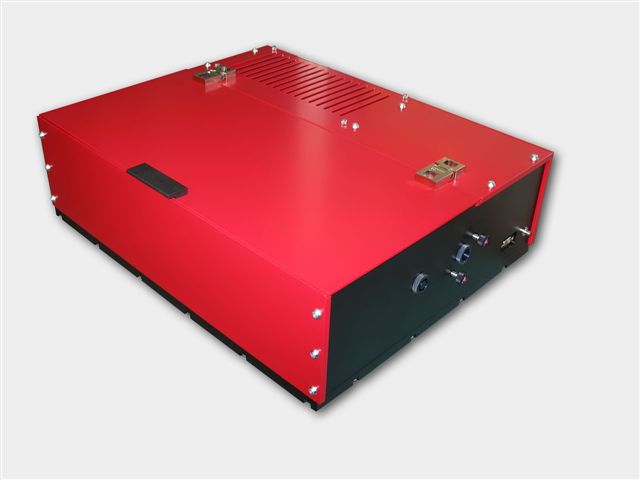 |
Trestles LH Ti:Sapphire
laser Trestles LH is a new series of high quality femtosecond Ti:Sapphire lasers for applications in scientific research, biological imaging, life sciences and precision material processing. Trestles LH includes integrated sealed, turn-key, cost-effective, diode-pumped solid-state (DPSS). Trestles LH lasers offer the most attractive pricing on the market combined with excellent performance and reliability. DPSS LH is a state-of-the-art laser designed for today’s applications. It combines superb performance and tremendous value for today’s market and has numerous advantages over all other DPSS lasers suitable for Ti:Sapphire pumping. Trestles LH can be customized to fit customer requirements and budget. Reserve a
spot in our Femtosecond lasers training
workshop in San Diego, California. Come to learn how to build a
femtosecond laser from a kit |
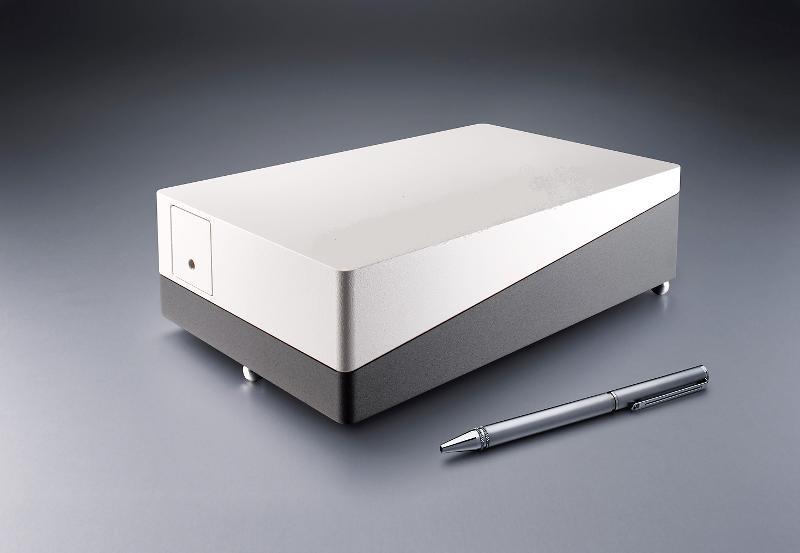 |
DPSS DMPLH lasers |
 |
New laser spectrometer
T&D-scan for research that
demands high resolution and high spectral
density in UV-VIS-NIR spectral domains - now available with
new pump option! The T&D-scan includes a CW ultra-wide-tunable narrow-line laser, high-precision wavelength meter, an electronic control unit driven through USB interface as well as a software package. Novel advanced design of the fundamental laser component implements efficient intra-cavity frequency doubling as well as provides a state-of-the-art combined ultra-wide-tunable Ti:Sapphire & Dye laser capable of covering together a super-broad spectral range between 275 and 1100 nm. Wavelength selection components as well as the position of the non-linear crystal are precisely tuned by a closed-loop control system, which incorporates highly accurate wavelength meter. Reserve a
spot in our CW lasers training
workshop in San Diego, California. Come to
learn how to build a
CW
Ti:Sapphire laser from a kit |
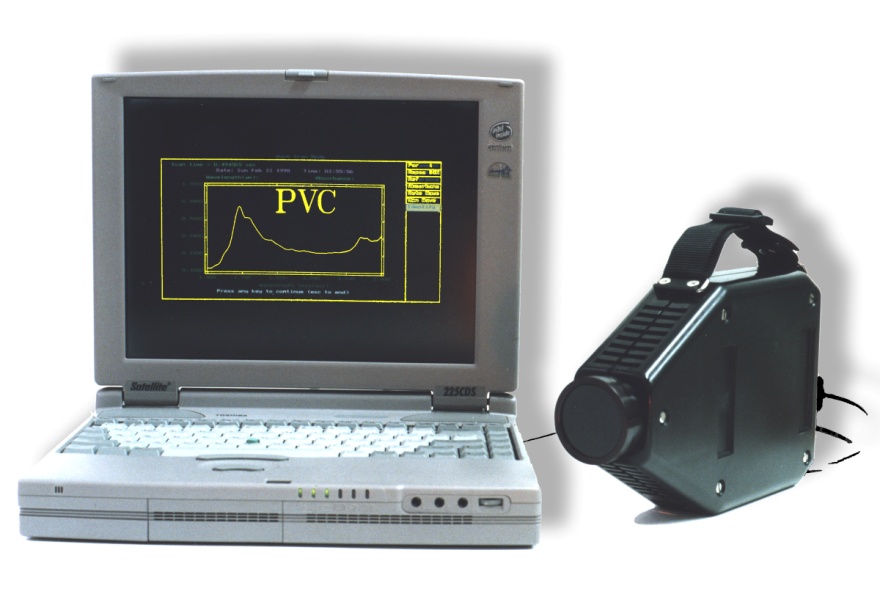 |
AOTF Infrared Spectrometer |
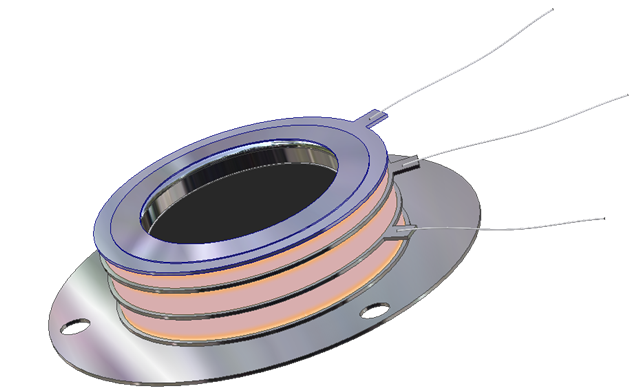 |
Open Microchannel Plate Detector
MCP-MA25/2 -
now in stock! |
 |
Hummingbird EMCCD camera The digital Hummingbird EMCCD camera combines high sensitivity, speed and high resolution. It uses Texas Instruments' 1MegaPixel Frame Transfer Impactron device which provides QE up to 65%. Hummingbird comes with a standard CameraLink output. It is the smallest and most rugged 1MP EMCCD camera in the world. It is ideally suited for any low imaging application such as hyperspectral imaging, X-ray imaging, Astronomy and low light surveillance. It is small, lightweight, low power and is therefore the ideal camera for OEM and integrators. buy online |
 |
Hatteras-D
femtosecond transient absorption data acquisition system Future nanostructures and biological nanosystems will take advantage not only of the small dimensions of the objects but of the specific way of interaction between nano-objects. The interactions of building blocks within these nanosystems will be studied and optimized on the femtosecond time scale - says Sergey Egorov, President and CEO of Del Mar Photonics, Inc. Thus we put a lot of our efforts and resources into the development of new Ultrafast Dynamics Tools such as our Femtosecond Transient Absorption Measurements system Hatteras. Whether you want to create a new photovoltaic system that will efficiently convert photon energy in charge separation, or build a molecular complex that will dump photon energy into local heat to kill cancer cells, or create a new fluorescent probe for FRET microscopy, understanding of internal dynamics on femtosecond time scale is utterly important and requires advanced measurement techniques. Reserve a
spot in our Ultrafast Dynamics Tools
training workshop in San Diego, California. |
|
|
Beacon Femtosecond Optically Gated Fluorescence Kinetic Measurement System
-
request a quote -
pdf Reserve a
spot in our Ultrafast Dynamics Tools
training workshop in San Diego, California. |
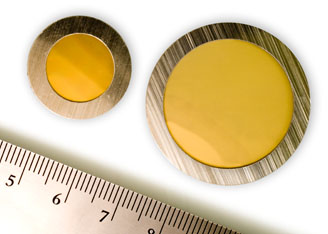 |
Terahertz systems, set ups and components New band pass and long pass THz optical filters based on porous silicon and metal mesh technologies. Band pass filters with center wavelengths from 30 THz into GHz range and transmissions up to 80% or better. Standard designs with clear aperture diameters from 12.5 to 37.5 mm. Long pass filters with standard rejection edge wavelengths from 60 THz into GHz range. Maximum transmission up to 80% or better, standard designs at 19.0 and 25.4 mm diameters. Excellent thermal (from cryogenic to 600 K) and mechanical properties THz products: THz Spectrometer kit with Antenna THz transmission setup THz time domain spectrometer Pacifica fs1060pca THz time domain spectrometer Pacifica fs780pca THz detectors: Golay cell and LiTaO3 piroelectric detectors PCA - Photoconductive Antenna as THz photomixer Pacifica THz Time Domain Spectrometer - Trestles Pacifica Holographic Fourier Transform Spectrometer for THz Region Wedge TiSapphire Multipass Amplifier System - THz pulses generation Terahertz Spectroscopic Radar Mobile System for Detection of Concealed Explosives Band pass filters with center wavelengths from 30 THz into GHz range Long pass filters with standard rejection edge wavelengths from 60 THz into GHz range Generation of THz radiation using lithium niobate Terahertz crystals (THz): ZnTe, GaP, LiNbO3 - Wedge ZnTe |
 |
iPCA - interdigital Photoconductive Antenna for terahertz waves Large area broadband antenna with lens array and high emitter conversion efficiency iPCA with LT-GaAs absorber, microlens array for laser excitation wavelengths l £ 850 nm, adjusted hyperhemispherical silicon lens with a high power conversion efficiency of 0.2 mW THz power / W optical power. The iPCA can be used also as large area THz detector. The two types iPCAp and iPCAs have the same active interdigital antenna area but different contact pad directions with respect to the electrical THz field. Interdigital Photoconductive Antenna for terahertz waves generation using femtosecond Ti:Sapphire laser THz books |
 |
IntraStage lowers the cost
of test data management! Struggling with gigabytes or terabytes of test data? IntraStage easily transforms test data from disparate sources into web-based quality metrics and engineering intelligence you can use.
Contact
us today to discuss your test management requirements and specifications of your
application. |
Training Workshops
|
|
Come to San Diego next summer! Attend one of our training workshops in San Diego, California
during summer 2011 Del Mar Photonics has presented training workshops for customers and potential customers in the past 3 years. Our workshops cover scientific basics, technical details and provide generous time for hands-on training. Each workshop is a three-day seminar conducted by professional lecturer from 10am to 4pm. It includes lunch, as well as a training materials. We have also reserved two days for Q&A sessions, one-on-one system integration discussions, social networking, and San Diego sightseeing.
The following training workshops will be offered during this
summer: |
Featured Customer
|
|
Trestles LH10-fs/CW laser system at UC Santa Cruz Center of Nanoscale Optofluidics
Del
Mar Photonics offers new
Trestles fs/CW laser system which can be easily
switched from femtosecond mode to CW and back. Having both modes of operation in one system dramatically increase a
number of applications that the laser can be used for, and makes it an ideal
tool for scientific lab involved in multiple research projects. |
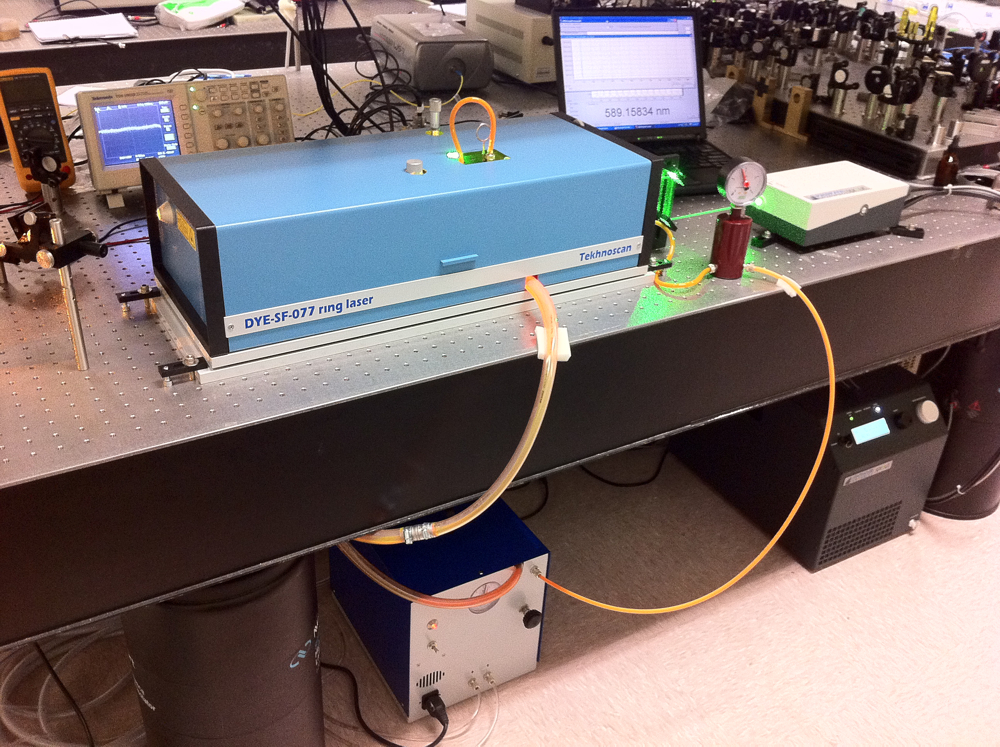 |
Frequency-stabilized CW single-frequency ring Dye laser DYE-SF-007 pumped by DPSS DMPLH laser installed in the brand new group of Dr. Dajun Wang at the The Chinese University of Hong Kong. DYE-SF-077 features exceptionally narrow generation line width, which amounts to less than 100 kHz. DYE-SF-077 sets new standard for generation line width of commercial lasers. Prior to this model, the narrowest line-width of commercial dye lasers was as broad as 500 kHz - 1 MHz. It is necessary to note that the 100-kHz line-width is achieved in DYE-SF-077 without the use of an acousto-optical modulator, which, as a rule, complicates the design and introduces additional losses. A specially designed ultra-fast PZT is used for efficient suppression of radiation frequency fluctuations in a broad frequency range. DYE-SF-077 will be used in resaerch of Ultracold polar molecules, Bose-Einstein condensate and quantum degenerate Fermi gas and High resolution spectroscopy |
Other News
Optical Society of Southern California meeting at UCSD OSSC 2011-04-27
Nd:YAG laser ordered by the University of Leon, UANL, Mexico
Wedge 50 Multipass Amplifier pumped with a Darwin-527-30-M DPSS Laser
ordered by Hong Kong customer
New
Trestles LH10-fs/CW femtosecond+CW laser ready for delivery to the
University of California Santa Cruz
Trestles femtosecond
Ti:Sapphire laser delivered to North Carolina State
University
Del Mar Photonics sponsor IONS (International OSA Network of Students)
conference IONS-NA-2 in Tucson, Arizona
IONS-NA-2
website
Best talk and best
poster awards at IONS-Moscow 2010 conference sponsored by Del Mar Photonics
Watch Del Mar Photonics
videos!
Del Mar Photonics is now on Twitter!
Del Mar Photonics featured components
Del Mar Photonics continuously expands its components portfolio.
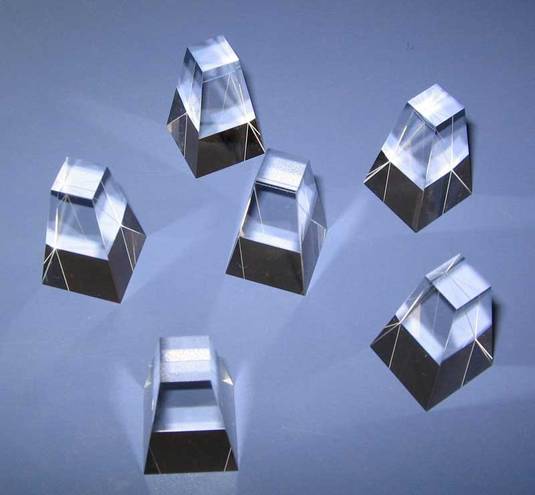 |
Solar
Prisms for Concentrating Photovoltaic Systems (CPV) Solar cells made of compound semiconductors such as gallium arsenide are very expensive. Usually very small cells are installed and various means such as mirrors, lenses, prisms, etc..are used to concentrate sunlight on the cells. Concentration photovoltaic technology (CPV) uses the solar radiation with an efficiency of 40%, double that of conventional solar cells Del Mar Photonics design custom Concentrating Photovoltaic Systems (CPV) and supply variety of the optical components for CPV such as solar prisms shown in the picture. |
|
|
Axicon Lens Axicon lens also known as conical lens or rotationally symmetric prism is widely used in different scientific research and application. Axicon can be used to convert a parallel laser beam into a ring, to create a non diffractive Bessel beam or to focus a parallel beam into long focus depth. Del Mar Photonics supplies axicons with cone angles range from 130° to 179.5° for use with virtually any laser radiation. We manufacture and supply axicons made from BK7 glass, fused silica and other materials. download brochure - request a quote |
 |
Rutile (TiO2) coupling
prisms Del Mar Photonics offers optical elements made of high quality synthetically grown Rutile Titanium Dioxide crystals. Rutile’s strong birefringency, wide transmission range and good mechanical properties make it suitable for fabrication of polarizing cubes, prisms and optical isolators. Boules having high optical transmission and homogeneity are grown by proprietary method. Typical boules have 10 - 15 mm in dia. and up to 25 mm length. Optical elements sizes - from 2 x 2 x 1 mm to 12.7 x 12.7 x 12.7 mm. Laser grade polish quality is available for finished elements. So far we the largest elements that we manufactured are 12 x15 x 5 mm, in which optical axis is parallel to 15 mm edge, 5 mm is along beam path, 12 x 15 mm faces polished 20/10 S/D, one wave flatness, parallelism < 3 arc.min. (better specs. available on request). more details - download brochure - request a quote |
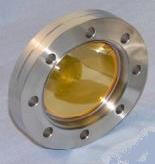 |
Vacuum viewport Del Mar Photonics offer a range of competitively priced UHV viewports , Conflat, ISO or KF including a variety of coatings to enhance performance. Del Mar Photonics viewports are manufactured using advanced techniques for control of special and critical processes, including 100 percent helium leak testing and x-ray measurements for metallization control. Windows Materials include: Fused silica, Quartz , Sapphire , MgF2, BaF2, CaF2, ZnSe, ZnS, Ge, Si, Pyrex. Standard Viewing diameters from .55" to 1.94 ". Coating - a range of custom coatings can applied - which include - Single QWOT - Broad Band AR - V coatings - ITO - DLC (Diamond like coating) more details - request a quote |

|
Hydrogen
Thyratrons are used in
such devices as radars with different power levels, high-power pulsed
technical, electrophysical, medical devices and lasers. Sophisticated
design and high quality ceramic-metal envelope determines long lifetime
and very accurate and reliable operation of hydrogen thyratrons under wide range of environmental
conditions. Applications: - radars - pulsed lasers power supplies - medical apparatus - electrophysical instrumentation Triggered Three-Electrode Spark Gap Switches are ceramic-metal sealed off gas discharge trigatron-type devices with a co-axial trigger electrode. These Gas Discharge Tubes contain no mercury and, due to an advanced design, feature high reliability and a long lifetime being operating under wide range of environmental conditions. Applications: - pulsed installation for processing materials - installations with plasma focus - pulse power supplies for lasers and other pulse equipment - medical apparatus such as lithotriptors and defibrillators - processing systems for petroleum wells |
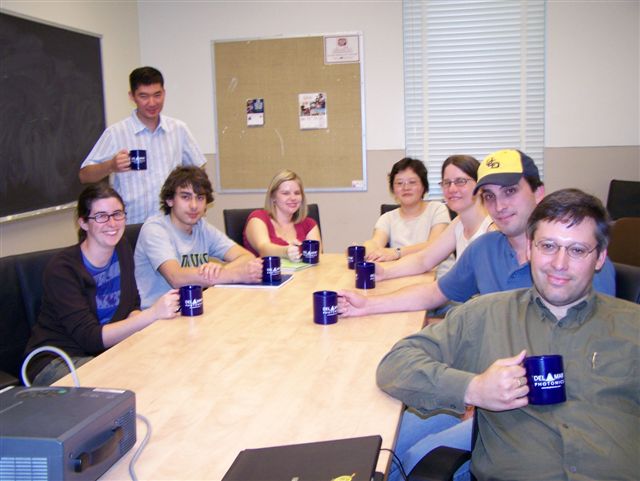 |
We are looking forward to hear from you and help you with your optical and crystal components requirements. Need time to think about it? Drop us a line and we'll send you beautiful Del Mar Photonics mug (or two) so you can have a tea party with your colleagues and discuss your potential needs. |
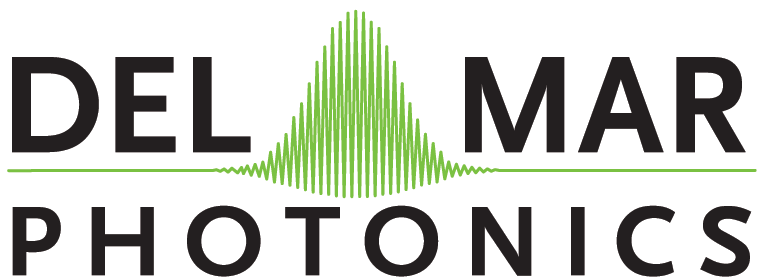
Del Mar Photonics, Inc.
4119 Twilight Ridge
San Diego, CA 92130
tel: (858) 876-3133
fax: (858) 630-2376
Skype: delmarphotonics
sales@dmphotonics.com